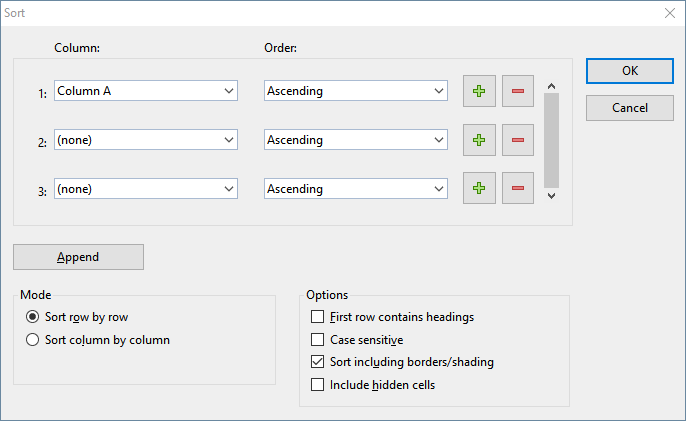With the sort commands on the ribbon tab Data | group Filter, you can sort a cell range.
Tip: You will also find the commands on the ribbon tab Home | group Contents | Sort and filter.
Simple sorts: Quickly via the direct commands
If you only want to apply the sort to a certain column, you can do this using directly the commands Sort ascending and Sort descending.
You can also select a cell range across several columns; in this case, the left column of the selected range is sorted. The selected values to the right of it follow their left value in the same row.
Select the cell range you want to sort and then choose one of the following commands on the ribbon tab Data | group Filter:
▪Ascending 
| The data of the selected column is sorted in ascending order (A-Z). |
▪Descending 
| The data of the selected column is sorted in descending order (Z-A). |
If, on the other hand, you want to apply different sort criteria to the columns of a selected cell range or set additional options, choose command Sort to open the dialog box (see below).
Sorting with different criteria: Via the dialog box
With the ribbon command Sort you can open a dialog box with additional sort options.
To do so, proceed as follows:
| 1. | Select the cell range to be sorted. |
| 2. | Choose the ribbon command Data | group Filter | Sort  . . |
| 3. | The following dialog box opens: |

| 4. | Choose at 1: the Column you wish to sort on. |
| 5. | Next to the column, you can choose the Order of the sorting: Ascending (A to Z) or Descending (Z to A). |
| 6. | If required, you can choose additional columns to sort on at 2: and 3:. |
| If, for example, you choose a column containing family names at 1: and a column with first names at 2:, the cell range will be sorted by the family name – and then, in groups of identical family names, by the first name. |
| 7. | Make any further settings as required, see below. |
As soon as you confirm with OK, the cell range will be sorted accordingly.
Options of the dialog box
The dialog box offers the following options:
▪Column and Order
| Here, select the desired column(s) to determine the sorting sequence. |
| You can also specify the sorting direction for each column: Ascending goes from A to Z, and Descending goes from Z to A. |
| By default, up to 3 columns can be specified. You can even add additional columns, if you need more than 3 sort criteria. Up to 64 columns are supported. Proceed as follows: |
| Adding a column: Click the Plus icon to add an additional column at the respective position. |
| Appending a column: Click the Append button (below the list) to append a column at the bottom. |
| Removing a column: Click the Minus icon to remove the respective column. (This only works if there are more than 3 columns) |
▪Sort row by row or Sort column by column
| Determines whether PlanMaker sorts by row or by column. |
▪First row contains headings
| If the first row or column of the selected cells contains a heading, enable this option. PlanMaker omits it from the sorting. |
| Example: You have selected a list of postal addresses that you want to sort by row. The first line of your selection contains headings such as "Name", "Street", "City", etc. The actual addresses are in the rows below. If you enable this option, the first row is not sorted along with the addresses, but stays on top. |
▪Case sensitive
| If you enable this option, sorting distinguishes between uppercase and lowercase letters. For example, all words that begin with a lowercase letter end up in front of the words that begin with a capital letter: |
| Disabled: Apples, bananas, Cherries. Enabled: bananas, Apples, Cherries. |
▪Sort including borders/shading
| If this option is enabled, cells moved by the sorting operation take their assigned border lines and shading with them. |
| If disabled, the selected cell range keeps its original layout as far as borders and shading is regarded. |
▪Include hidden cells
| If the selected range contains cells that have been hidden (see Showing and hiding rows/columns), these are normally not sorted. Enable this option if you want hidden cells to be included in the sort. |
![]()
![]()
